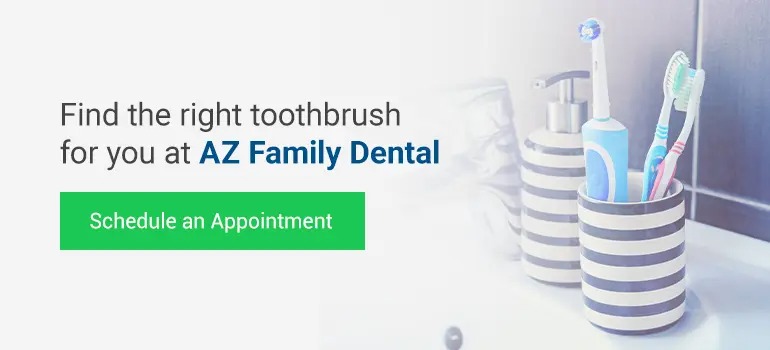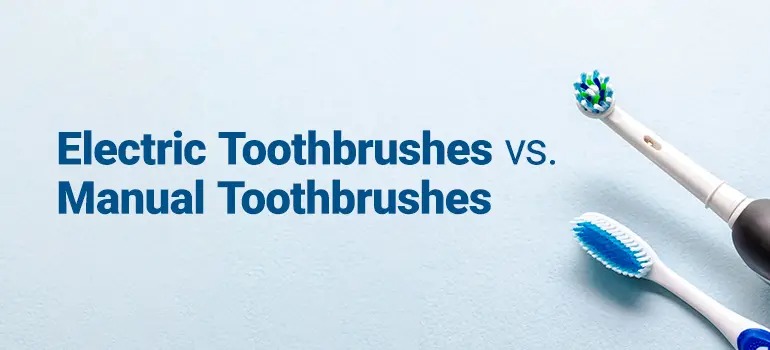
A toothbrush is an invaluable tool for maintaining your oral hygiene. As the years progress though, new and updated technologies line the shelves of dental care aisles, leaving you wondering if you should be doing more to protect your teeth.
With numerous appealing products on display, deciding what kind of toothbrush you need most can be overwhelming. We put together a list of pros and cons for manual and electric toothbrushes, which each have benefits and limitations to consider.
Is It Time to Upgrade Your Toothbrush?
Technology continues to progress in all areas, and dental health is no different. As more electric models come into circulation, you might be wondering if it’s time to make a switch. Electric toothbrushes have come a long way, so we are here to help you evaluate if the purchase is worthwhile.
It might be time to upgrade to a newer brand of toothbrush if you’re tired of using a manual one. Choosing an electric toothbrush gives you access to features traditional toothbrushes don’t have, and it’s easy to find one that suits your needs. The selection of these upgraded models is nearly as vast as traditional toothbrushes. If you like using the electric version better, you will know you have made an investment that you can recommend to others.
Overcoming Operational Limitations
Are you struggling with mobility problems that make proper dental hygiene a struggle? An electric toothbrush could help make your brushing routine much more comfortable. One reason that clients might want to try switching is due to the extra support an automatic model can provide. We find that clients who switch due to mobility reasons are nearly always satisfied with their decision.
Getting Kids Interested in Hygiene
Do you have a hard time getting your kids to brush their teeth? Similar to their adult patients, doctors recommend that children brush on a daily schedule or after eating a meal. With an electric toothbrush, you can show your kids how fun and easy brushing can be. Many automatic toothbrushes even have helpful features that simplify the training process for young children and give teenagers clear guidance for how to brush properly.
Caring for Orthodontic Devices
Are you interested in getting a new toothbrush because you recently had orthodontic work? Some clients look for a toothbrush that accommodates their braces. Regardless of which toothbrush you go with, we suggest also using floss. You can also buy dental sticks to clean between your braces. Some electric toothbrushes are marketed to clean around orthodontic attachments, particularly models classified as water picks.
The Advantages of a Manual Toothbrush
Before you commit to an electric toothbrush, you should be aware that using a manual toothbrush has advantages of its own. Manual toothbrushes have remained in stock after centuries of use. Even as toothbrush technology advances, it’s safe to say that the old-fashioned manual model’s popularity will persist in the coming years. If you like your toothbrush now, you might prefer to keep using the same brand in the future.
Widely Available
Manual toothbrushes are sold at nearly every grocery store or pharmacy. They are the most commonly purchased dental hygiene supply, and their demand has increased significantly even after the advent of the electric toothbrush. They are sold in nearly every city across the globe, but automatic toothbrushes are harder to come by, with fewer retailers stocking them and a narrower company market.
Affordable to Own
Although manual toothbrushes come with a range of features that influence their price, they are among the most affordable models around. You can purchase a standard toothbrush for as little as $1-3 and replace it after several weeks of daily use. In fact, the Centers for Disease Control and Prevention recommends replacing your manual toothbrush every three to four months.
Sometimes Better for Comfort
Clients with gum sensitivity or those who have a case of gingivitis might feel more comfortable using a manual toothbrush. Oscillating toothbrushes are safe to use on sensitive gums, but with a manual toothbrush, you can control your speed with your grip and move more slowly if you feel it is needed. Some clients dislike the vibrating motion of the electric toothbrush, while others find it soothing.
Easily Replaceable
If you or your child is recovering from a sinus infection or another contagious illness, you can always throw out your old toothbrush and start using a new one. With an electric toothbrush, you may think twice about throwing away if you haven’t gotten full use out of it. All toothbrushes are replaceable, but buying the more affordable models to keep on hand in your bathroom cabinets means paying less per year on the total cost of dental care.
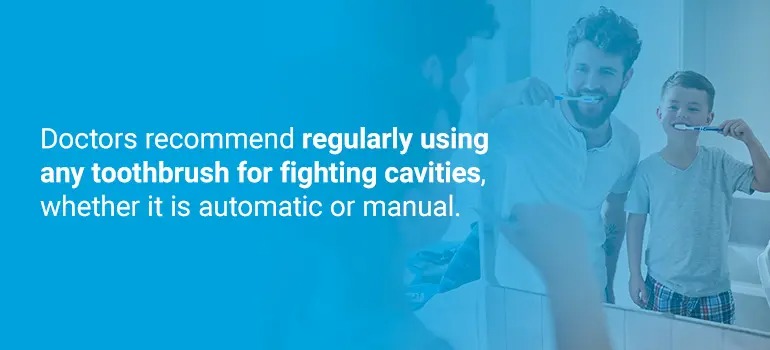
Research Shows Effectiveness
Studies conducted on electric toothbrushes show the manual kind is nearly as effective. These trials indicate slightly superior results for automatic toothbrushes, without a significant improvement in the oral hygiene of those using the updated models. Doctors recommend regularly using any toothbrush for fighting cavities, whether it is automatic or manual.
The Disadvantages of a Manual Toothbrush
Manual toothbrushes may operate without problems, but they can be inconvenient compared to the automatic kind. As we highlighted above, manual toothbrushes are durable and dependable, but they are also vulnerable to user error. Knowing how to brush your teeth properly is the best way to avoid these disadvantages.
Brushing Without a Timer
Many of us have a short window of time every morning and evening to brush for the American Dental Association’s recommended length of at least two minutes. If you use a manual toothbrush, you have to rely on your best judgment to know when to rinse. This also means that you can accidentally over-brush by spending longer at the sink than you need to.
Brushing Without a Pressure Sensor
It’s possible to brush too hard when using a manual toothbrush. Researchers have discovered that manual toothbrushes pose a risk of abrasiveness that many electric toothbrush models are designed to safeguard against.
Needing a Toothbrush Container
Most manual toothbrushes are sold separately from a carrying case or container, except for compact toothbrushes marketed for traveling. To keep the bristles of your toothbrush sanitary, you are required to buy a container to store it. Many automatic toothbrushes can sit upright on the countertop or other flat surfaces, and some come with caps to seal off the head after each use.
The Advantages of an Electric Toothbrush
Many clients are motivated to buy an electric toothbrush because they want a more powerful brushing tool. The electric toothbrush has numerous benefits, but it’s important to remember not all models are built the same. We recommend doing research on quality products before you make a selection to enjoy all the possible advantages.
Research-Backed Efficiency
Numerous studies have contributed to a growing pool of research in support of the electric toothbrush’s superiority for reducing plaque and gingivitis. One study found an 11% reduction in plaque after up to three months of use. Even better, automatic models improve in efficiency every year as the products are updated frequently according to recent testing data.
Better for Orthodontic Devices
When you have to brush around your braces and attachments, an automatic toothbrush makes your routine faster and more efficient. Electric toothbrushes pack more brushing power, allowing them to clean between orthodontic appliances with less effort. As you receive the gradual benefits of corrective alignment from your orthodontic devices, you might want to use an automatic toothbrush to prevent tartar from building between your teeth. To protect against this buildup, you can also use dental floss and dental sticks.
Timed Brushing
Some electric toothbrushes come with built-in timers. This supportive feature makes it easier to brush for the right amount of time, which is great for coaching children and teenagers too.
Easier to Use With Mobility Limitations
Since electric toothbrushes move on their own, many people with disabilities or other mobility limitations find them easier to use. They operate without the quick wrist movements manual models require.
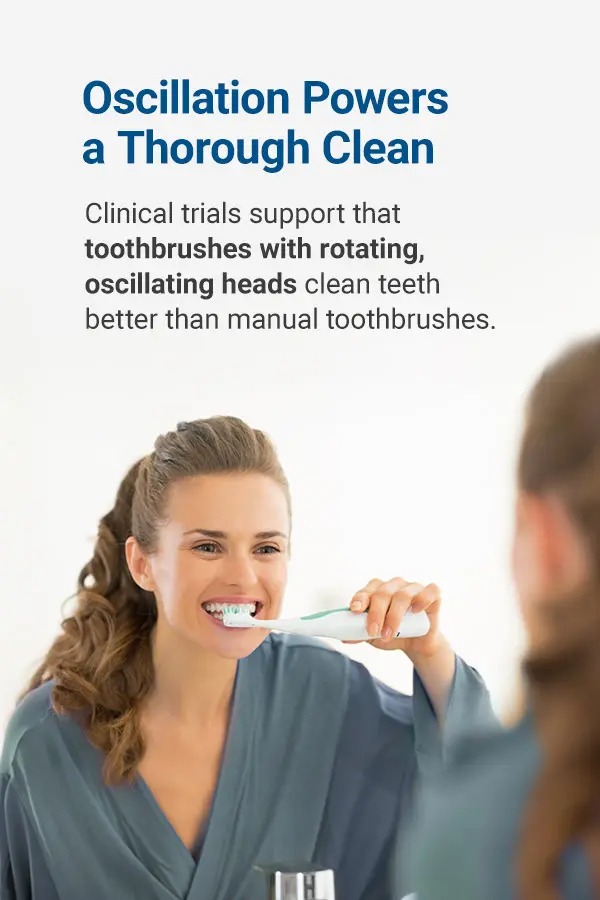
Oscillation Powers a Thorough Clean
Clinical trials support that toothbrushes with rotating, oscillating heads clean teeth better than manual toothbrushes. Some automatic models vibrate in place without a rotation, so if you’re looking for an oscillating one, read the product’s description carefully and review the key features.
User-Friendly Gum Protection
Automatic toothbrushes are designed to gently clean along the gum line at a 45-degree angle, and the more expensive models come with pressure sensors to warn you when you’re brushing too hard. This feature provides protection for sensitive gums and ensures that you brush appropriately.
Potentially Less Waste
Getting a durable electric toothbrush means less to throw away in the long run. However, if you get the cheaper, disposable electric toothbrushes to cut costs, you will also have to throw away old batteries, resulting in rechargeable models creating the least amount of waste.
Enjoyable for Kids
Many kids gravitate toward the electric model when given the opportunity. They appreciate the upgrade because of how updated and simple it makes their hygiene routine. Certain brands produce electric toothbrushes designed specifically for kids.
The Disadvantages of an Electric Toothbrush
Although electric toothbrushes are great at what they were designed to do, they are not without drawbacks. If you’re interested in switching and want to know if an electric toothbrush is worth the money, you should be aware of the possible cons. Clients who prefer electric toothbrushes think many of their disadvantages are minor in comparison to the benefits they receive from using them, but it ultimately boils down to your personal preferences.
Getting Used to One
If you or your child has only used manual toothbrushes in the past, the vibration speed and rotation of an electric toothbrush could take getting used to. Some people find the switch uncomfortable and opt to stay loyal to their older style of toothbrush instead.
Finding an Inexpensive Product
Manual toothbrushes are typically cheaper to replace. In fact, the average electric toothbrush costs at least $40, but premium brands with additional features can be as expensive as $200. For a disposable battery-operated toothbrush, you can expect to pay around $5-25, which isn’t bad at all. You might require a more expensive automatic toothbrush for your specific needs or you might come to prefer a more durable brand, leading to a higher expense in the long run.
Tracking Down Replacement Parts
Replacement heads for your electric toothbrush might be available at your local retail stores, but otherwise, you will have to order them online. It’s a good idea to always have a box of extras on hand in case you need to make a hasty replacement.
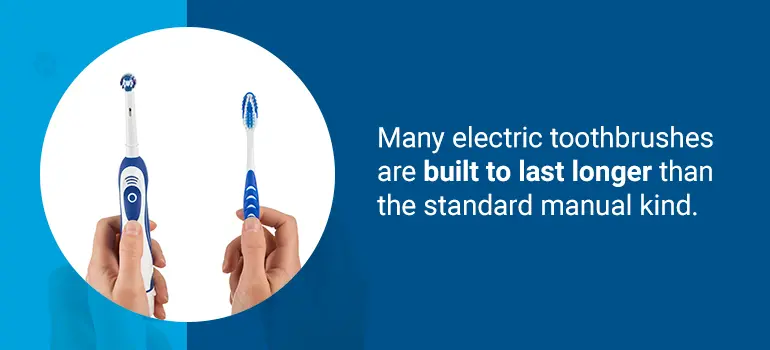
Having to Do Maintenance
Many electric toothbrushes are built to last longer than the standard manual kind. This means that instead of replacing yours every two months, you will either have to replace the head or clean it using the special care instructions provided with the product. Taking care of your toothbrush is generally an easy, fast process, and some models only require a simple replacement of the attachment that enters the mouth.
The Bristles Wearing Down
An electric toothbrush can land thousands of strokes per minute, and this speed comes can lead to the bristles gradually softening until the toothbrush doesn’t clean as effectively. If your model comes intact without replaceable heads, you will have to buy a new one eventually. Even though you would have to replace a manual brush more frequently than most automatic ones, some clients feel that the higher cost of an electric toothbrush offsets its potential lifespan.
The Possible Lack of Necessity
You might not need to switch to an electric toothbrush if your manual toothbrush has always worked effectively to prevent cavities. Either style of toothbrush works successfully as a tool for dental hygiene maintenance. Any debate over which toothbrush works the most effectively reflects that either kind is at least fully functional.
Less Space
Electric toothbrushes are larger than most manual models, and they often come with attachments and other accessories. They typically take up more space than a manual toothbrush, requiring more territory in your cabinet or a larger pocket in your suitcase.
Travel Restrictions
If you travel internationally, you might need to bring a manual travel-sized toothbrush anyway. You would need a power plug adaptor to use your electric toothbrush in wall plugs designed for domestic products. This factor tends to be a concern for clients who frequently travel out of the country, who might have to purchase another electric toothbrush that will work as a compatible appliance.
Ask AZ Family Dental About Finding the Perfect Toothbrush
At AZ Family Dental, we care about the health of your teeth and gums. Your comfort takes precedence, whether you prefer a manual or an electric toothbrush. Regardless of your preference, brushing daily is vital for keeping away bacteria and plaque. The right toothbrush will help you and your children maintain your dental hygiene.
Contact us for more information about toothbrushes or to schedule an appointment for a cleaning at our Glendale office.
